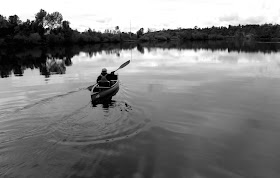Thy waves are old companions, I shall see
A well-remembered form in each old tree
And hear a voice long loved in thy wild minstrelsy --- Joseph Rodman Drake
Walking down the narrow dirt trail along the river, I heard the sound of the rush of water. It was unexpected.
My wife and I were visiting New York City to do the usual things when visiting the city. Take in a show, tour its museums and checkout its sight and sounds of the Big Apple.
But the coronavirus outbreak dashed a few those plans with cancellations and closings. We were lucky to see what we did, as the city succumbed to the dread of things to come. We found ourselves either being the last one to visit or lockout places we wanted to see. On their doors a sign reading: Due to the coronavirus, we are temporarily closed.
Visiting the New York Botanical Garden is not ideal on the last days of winter, but the trip through the historic Enid A. Haupt Conservatory exhibition's annual orchid show's kaleidoscope colors proved to be an amazing experience.
Touring the grounds afterward, like always, I heard the river's call.
The Bronx River flows along a narrow urban pathway for 24 miles through southeast New York, past several communities and parks before it empties into the East River. Once a neglected dumping ground, filled with trash, old tires, cars, and refrigerators stock-piled for miles along an abandoned waterfront, it was commonly referred to as a "sewersheds rather than watersheds in the Bronx."
But in recent decades the river has undergone an extraordinary transformation and recovery that has turned the waterway into one of the crown jewels of New York City Parks Department. The river parkway is now a haven for recreation and wildlife viewing throughout the heart of the Bronx with restored shorelines, fields of flowers, and thick stands of trees.
"For me, what’s so special about the Bronx River is that it’s been a community-driven process. The vision for this has come from community groups and it’s been driven by community groups," said Bronx River Alliance's, an organization which has worked to restore the river, Maggie Greenfield in a 2016 interview with Curbed, "I find that the most meaningful part of this work."
Along the trail, I came across a canoe trail portage sign, that to me seemed out of place. I couldn't think of anyone paddling here, but they do. In checking the Bronx River Alliance's website, I found they hold paddling events throughout the summer including their popular Amazing Bronx River Flotilla that they have hosted every spring for the past 20 years. According to their paddling information, the water may be quite shallow but it's still very navigable. You can plan on scraping the bottom of your canoe on rocks in spots along the way, especially during the summer.
Looking over the camelback stone arched Hester Bridge, as the river rumbled underneath, I can see the Snuff Mill dam that was constructed in 1840 to power the neighboring Snuff Mill that's just downstream. The still-intact mills' old stone walls and brick trim that now provide space for parties and wedding receptions.
The dam and shallow small rapids are a picturesque site but create a difficult passage. Canoe portaging is recommended along the path.
And it was a very easy walk along and a wonderful way to isolate myself from the urban complexity of the city, at least for a while.







